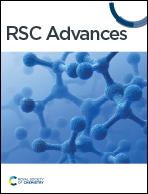NMR analysis of structural geometry and molecular dynamics in perovskite-type N(CH3)4CdBr3 crystal near high-temperature phase transition
Abstract
The NMR chemical shifts, linewidths, spin–lattice relaxation times in the rotating system T1ρ, and spin–lattice relaxation times in the laboratory system T1 were evaluated for the perovskite-type N(CH3)4CdBr3 crystal, aiming to understand the changes in the structural geometry and molecular dynamics from phase I to phase II. From the temperature-dependence of the 1H, 13C, 14N, and 113Cd NMR chemical shifts, the structural geometry underwent a continuous change, without anomalous changes around (TC = 390 K). However, the linewidths in phase I were narrower than those in phase II, indicating that the motional averaging effects were caused by the rapid rotation of the N(CH3)4 group. Sudden changes in T1 and T1ρ were observed near TC, for which the activation energy Ea in phase I was approximately 12 times larger than that in phase II; the small Ea values in phase II indicate a large degree of freedom for the methyl group and CdBr6 octahedra, whereas the large Ea in phase I was primarily attributed to the overall N(CH3)4 and the 113Cd in the CdBr6 groups. Consequently, the phase transition mechanisms of N(CH3)4CdBr3 are related to reorientation of the N(CH3)4 group and the arrangement of the CdBr6 groups.



 Please wait while we load your content...
Please wait while we load your content...